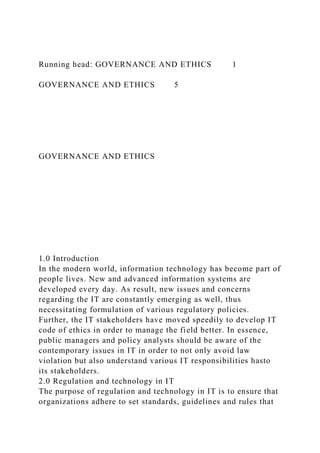
Governance and Ethics in IT
- 1. Running head: GOVERNANCE AND ETHICS 1 GOVERNANCE AND ETHICS 5 GOVERNANCE AND ETHICS 1.0 Introduction In the modern world, information technology has become part of people lives. New and advanced information systems are developed every day. As result, new issues and concerns regarding the IT are constantly emerging as well, thus necessitating formulation of various regulatory policies. Further, the IT stakeholders have moved speedily to develop IT code of ethics in order to manage the field better. In essence, public managers and policy analysts should be aware of the contemporary issues in IT in order to not only avoid law violation but also understand various IT responsibilities hasto its stakeholders. 2.0 Regulation and technology in IT The purpose of regulation and technology in IT is to ensure that organizations adhere to set standards, guidelines and rules that
- 2. govern how technology is applied within IT fields with the aim of protecting individual organizational stakeholders. For instance, there are regulations guiding entities on various procedures and security standards to ensure that publics’ information is protected. Government policies and ethics are the main regulatory strategies in the industry. (a) Government and Information Technology The purpose of government in IT field is to establish a formal framework for providing an organizational structure to make sure that investments in IT are in support of business objectives. The importance of governance in IT practices in American organizations was driven by the passage of regulations and laws including SOX Act and GLB Act which emanated from the fallout regarding various high-profile deception and corporate fraud cases (Falzone, 2013). (b) Ethics and Information Technology The aim of ethics in IT field is to create a culture of responsibility, integrity, excellence and trust while using the organizational resources. In addition, ethics enhances confidentiality and privacy of information as well as reducing unauthorized access with regard to computer systems thereby preventing dishonesty and conflicts. The research will address issues of ethical violations in IT such as unauthorized access to servers; systems administrator’s account thus violating the principle of privacy and confidentiality, among others. 2.2 Ethics and Responsibilities in IT (a) Code of Ethics in an Organization Codes of ethics are implemented within an organization with the aim of highlighting the ethical responsibilities with regard to users while utilizing information technology. Basically, codes of ethics provide written and formalized guidelines that govern the behavior of employees in relation to the application of information technology. This means that while ethics focuses on what is right or wrong, codes of ethics give guidelines for
- 3. enhancing the correctness of a certain behavior within the organization (Lindros, 2017). It is a legal responsibility because failure to protect such data may invite lawsuits against an organization. For example, a client whose information is leaked and distributed to third parties could sue the company on the basis of privacy violation. (b) Standards of Oversight in IT Oversight standards in IT encompass all the legal, community, individual and societal standards that make sure that the computer systems and networks remain intact or a system failure is not experienced. In other words, these are the standards that assist IT professionals in ensuring that the systems are protected from any possible compromises. These oversight standards involve physical, technical and administrative guidelines regarding IT. (i) Legal IT Responsibilities One of the major legal IT responsibilities is to ensure that the privacy, integrity and confidentiality of corporate data are protected. This data could include financials, clients’ information, information on investors etc. It should be noted that privacy is pretty much recognized even in the US constitution in that every individual has a right to privacy that also covers information(Falzone, 2013). This is a legal responsibility because failure to protect such data may invite lawsuits against the company in question. For example, a client whose information is leaked and distributed to third parties could sue the company on the basis of privacy violation. (ii) Societal IT Responsibility The IT is responsible for protecting the society against various societal threats or issues that are related to and which can be mitigated through using IT-related strategies. Although, IT has proved to be very beneficial to the society in terms of facilitating communication, travelling, doing business and learning, it has also caused various problems(Lindros, 2017). For example, IT has the responsibility of reducing cybercrime since it is also caused by it by improving cyber-security
- 4. measures. Cybercrime is a societal issue because it affects the peace and harmony of members of the society especially in the event of cyber terrorism. (iii) Community IT Responsibility IT owes the community a responsibility of promoting access and awareness with regard to how community members can utilize information with the aim of increasing efficiency in their operations, for example, pertaining to generation of income(Falzone, 2013). IT is enabling community members to learn and acquire knowledge regarding important things as well as distributing political and other public concerns information. (iv) Individual IT Responsibility IT has the responsibility of improving the lives of individuals through various ways that relate to acquiring and distribution of information. For example, through the internet, there is only a lot that an individual can learn including showcasing one’s talents, advertising individual products, seeking medical help etc. This is because through efficiency and effectiveness in information flow, an individual is able to benefit at a personal level. 3.0 Conclusion In conclusion, to prevent both public managers and policy analysts from acting against various regulations concerning information technology, and understand different responsibilities of IT to its stakeholders, it is important to educate them about the same. This way, they will be more effective in employing information technology in their day-to- day activities. References CFalzone, A. (2013). Regulation and Technology. Retrieved from http://cyberlaw.stanford.edu/publications/regulation-and- technology. Lindros, K. (2017). What is IT Governance? A Formal Way to Align IT and Business Strategy. Retrieved from